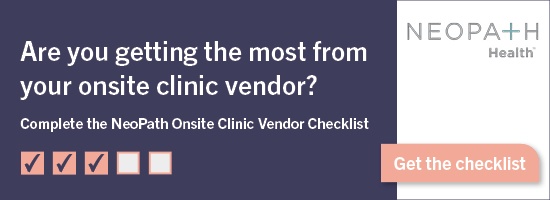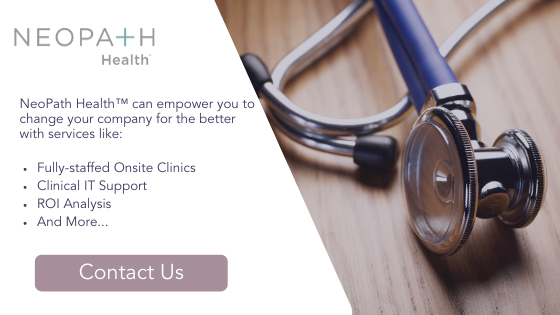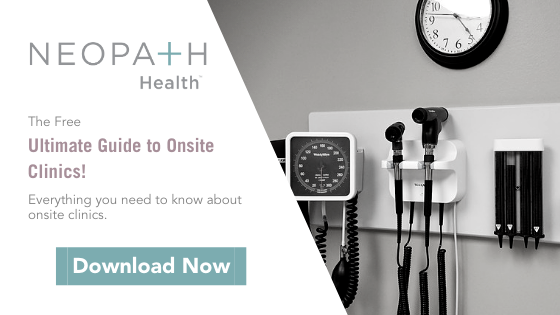Answer your questions around planning, financing and staffing a near-site or onsite clinic for your company.
If you’re reading this guide, you probably have a clear picture of the benefits of opening an onsite clinic for your company. From cost savings to proven health benefits, opening your own clinic unlocks untapped power in your workforce, enhancing the productivity, safety, engagement and culture within your organization.
But how do you get started?
We get it. The first steps can seem daunting. You are considering opening and staffing a whole new business unit that probably doesn’t have a lot to do with your core offering — you’re not running a hospital, right?
Don’t worry. To help you get started, we’ve outlined three phases of starting an onsite clinic:
- Phase 1: Planning and Feasibility
- Phase 2: Financing and Buildout
- Phase 3: Staffing and Administration

In the sections below, we’ll guide you through the critical questions around each phase and provide direction to share with your stakeholders as you plan for this project.
Phase 1: Planning and Feasibility Projections

You are HERE. Effective planning is the very first step towards a successful onsite clinic. You may have already begun the process of creating feasibility projections as you plan for this project. As you continue this critical phase, you should be asking the following questions:
- What type of care will my onsite clinic provide?
- How many employees will use the clinic services?
- What outcomes am I hoping to achieve?
- Do I really need an onsite clinic?
- How do I select the right onsite clinic partner?
What type of care will my onsite clinic provide?
Consider all the types of conditions your employees may need support to manage: chronic conditions, preventive services, fitness and wellness initiatives, behavior health, physical therapy, imaging and lab services.
This list of conditions and services may seem long, but remember — you know your employees. You probably already have an idea of what common health issues they face well enough to form a strong hypothesis of what you need.
Once you have a rough concept of what services you want to provide, use claims data from your claim administrator provider to uncover deeper, granular insights to help you plan.
While many companies choose to open a facility that manages all dimensions of health and wellness, you may choose to coordinate with other healthcare providers outside your company walls for specific types of care like specialist services, mental health needs, surgical or hospital services.
How many patients will use the clinic services?
Not only does a head count help you estimate cost, but it also tells you how big your physical clinic will need to be.
Still, even if you open the most comprehensive, high-quality care services for your employees, not every employee will use the service. It’s important to research existing healthcare utilization within your organization as you seek to define this critical metric. Plan for a bump in utilization, but you likely won’t see your full workforce using the clinic when it first opens.
Are you considering dependents on the health plan having access? Maybe you want everyone to have access regardless if they are on the health plan or not?
Keep this in mind, too: as your organization grows, the clinic will need to service a growing workforce. Think about how many employees you will service five years from now as you plan.
What outcomes am I hoping to achieve?
You’re opening this clinic for a reason. Have you taken the time to distill that motivation into clear, concise goals?
There are plenty of outcomes that an onsite clinic can help you achieve: more controlled healthcare costs, budget predictability, greater productivity, less absenteeism, better employee recruitment and retention and so many more.
Related Reading: 4 Reasons Why Corporate Healthcare Costs are Rising
As with any dimension of business strategy, measuring your outcomes is critical to success. Make sure you know what your key performance indicators (KPIs) are from the start, collect benchmarks and facilitate methods to efficiently collect and analyze new data around these KPIs.
How is HR tracking time and attendance to prove a reduction in absenteeism? Do you understand the full range of healthcare costs that you’re currently covering?
Defining your goals and creating a way to measure outcomes is a universal smart business practice that your new clinic needs, too.
Do you really need an onsite clinic?
You’ve gone through some key planning questions. Now, ask yourself — do I really need an onsite clinic for my business?
This is a moment of truth to reassess your needs. For example, let’s say you predict fewer than 200 employees will utilize your clinic. In most situations, that means you won’t need a facility with full operational hours. You may want to consider a part-time clinic, or perhaps you can partner with another business to open a joint facility.
As you plan, it’s important to challenge your original concept of a clinic with creative solutions that are sensitive to your real-world needs. What you actually need is likely a lot different than what you first envisioned.
How do I choose the right clinic partner?
With a strong idea of what health services you will provide, how many employees you will support and a set of measurable goals, you’re ready to seek out a partner to make your clinic concept a reality.
So, how do you choose the right partner? The most important thing to look for is whether or not they have built a clinic for your service volume before.
Experience matters when creating a medical facility. You need a contractor or partner that can meet your current volume and understands how to scale healthcare with your business growth.
Phase 2: Financing and Buildout

You’re ready to talk about the cost for your onsite clinic and the timeline. This is where your planning and feasibility projections will make a big difference — especially when it comes to selecting the right partner to help you build.
These are the key questions to consider in Phase 2:
- Where do the funds for this project come from?
- How do I gain buy-in to finance the project?
- Where does the clinic go?
Where do the funds for this project come from?
The funds are already in your budget! Remember, an onsite clinic should repurpose funds that are already set aside for healthcare costs. When trying to establish what you can afford, start by looking at what you presently spend on health insurance and health care for your employees.
How do I gain buy-in to finance the project?
When a large budget item like healthcare, you’re going to need to gain buy-in from your internal stakeholders more than one time. The simplest way to gain and keep that buy-in is through solid ROI projections.
The most basic ROI calculation is Clinic Value minus Clinic Cost. Finding these two values can be difficult on your own — that’s where a partner like NeoPath can help. Our formula is simple:

On average, ROI on onsite clinics will be just under 2:1 — for every dollar you put into your clinic, you could save an additional 75 cents.
Where does the clinic go?
It’s okay if you don’t know, but if your corporate campus doesn’t have the square footage for a new clinic, it’s important to begin searching for near-site locations as early as possible.
Market research, real estate searches and a quick dive into your local zoning and permitting requirements will help you discover the ideal location for your clinic and whether or not you’re going to build, renovate or buy. When you’re working with a clinic management firm like NeoPath, it may be helpful to have this research ready so that you can put together an accurate ROI projection.
Phase 3: Staffing and Administration

The daily operations of an onsite clinic are a true partnership. Many companies will rely on a third-party company to recruit staff or even run daily operations since medical expertise is not built into their daily operations.
As you consider the best route for your organization, think about these three questions:
- Where do I find a staff?
- What type of expertise do I need?
- Who will be working with my employees?
Where do I find staff?
Odds are, you’ve never had to recruit a doctor before! Many organizations will rely on the expertise of third-party staffing agencies to grow their clinic’s staff or partner with a clinic management company.
With NeoPath, every dimension of staffing your clinic is centralized, so you don’t have to go to multiple sources to find qualified people. We build the clinic and we manage it for you.
What type of expertise do I need in-house?
Clinics can be staffed with a range of healthcare experts — physicians, nurse practitioners and even personal trainers. Revisit your initial goals for the clinic to uncover what types of medical and health professionals you will need on-site.
Whatever you choose, it’s important that your providers are aligned with your company’s demographics and culture.
Who will be working with my employees?
Every workforce is unique, and the most successful onsite health programs take into account the demographic makeup of their workers when selecting a medical staff.
The stratification of sex, age, job category and more within your organization presents a unique set of needs and cultural requirements. You will need to select clinicians that are willing to learn how to appeal to your group. Otherwise, your utilization numbers will underperform.
Related Reading: The Ultimate Guide to Onsite Clinics
As you move through the phases of opening an onsite clinic, you will undoubtedly encounter more questions and challenges unique to your organization. Whatever those new, unique findings may be, one thing remains clear — smart investments in the health and wellness of your workforce always have great returns.
NeoPath is a start-to-finish partner to help you through each phase. Whether you’re ready to dive in or still have more questions, we’re here to help. Contact us today!
.png?width=433&name=NeoPath_2019_logo_2color%20(1).png)






